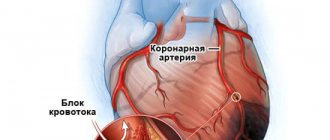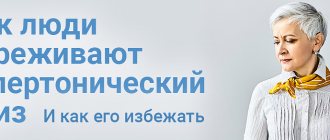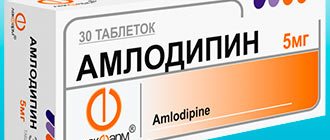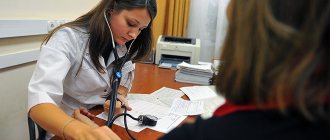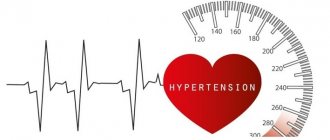First aid for hypertensive crisis
Hypertensive crisis
is a condition manifested by high blood pressure (BP) (systolic or “upper” blood pressure, usually more than 180 mm Hg; diastolic or “lower” blood pressure - more than 100 mm Hg) and the following main symptoms:
• headache, often in the occipital region, or heaviness and noise in the head;
• flashing “flies”, a veil or a net before the eyes;
• nausea, feeling of exhaustion, overwork, internal tension;
• shortness of breath, weakness, constant monotonous aching pain/discomfort in the heart area, sometimes the appearance or increase of pastiness/swelling of the skin of the face, arms, legs.
Algorithm for emergency actions in case of hypertensive crisis (advice to the patient)
If symptoms of a hypertensive crisis appear, you must:
• remove bright light, ensure peace, access to fresh air (unbutton your shirt collar, ventilate the room, etc.);
• measure blood pressure and, if its upper level is greater than or equal to 160 mm Hg. Art., you must take an antihypertensive drug previously recommended by your doctor. In the absence of a doctor-recommended antihypertensive drug or when a blood pressure level is recorded above 200 mm Hg. Art. urgently need to call an ambulance;
• before the arrival of emergency medical services, you must (if possible) sit in a chair with armrests and take a hot foot bath (put your feet in a container of hot water).
Attention!
A patient with a hypertensive crisis is prohibited from any sudden movements (suddenly standing up, sitting down, lying down, bending down), pushing hard and any physical activity.
• 40-60 minutes after taking the medicine recommended by the doctor, it is necessary to re-measure blood pressure and, if its level has not decreased by 20-30 mm Hg. Art. from the initial state and/or the condition has not improved, call an ambulance immediately.
• If you feel better and your blood pressure decreases, you need to rest (go to bed with the head of the bed raised) and then contact your local (family) doctor.
What to do if you are alone at home?
When a person is at home himself, it is not surprising that he is at a loss. It is important to take your medicine and open the front door. After this you call an ambulance. If you lose consciousness, doctors will be able to get into the house. The arriving team usually administers Dibazol, they use diuretics, and in case of significant tachycardia, beta blockers help. This is Inderal, or Rausedil and Obzidan.
You should definitely put Nifedipine or an analogue of Corinfar under your tongue. If the GC turns out to be complicated, then further measures are taken in the hospital. Sometimes ventricular failure occurs. If coronary insufficiency develops, the patient is placed in intensive care, where they try to relieve the pain. One of the most serious complications can be called a heart attack. This pathological condition requires resuscitation. It is necessary that the person is taken to the hospital as quickly as possible. This gives a chance to save the patient and minimize complications and their risks.
First aid for acute heart failure
Acute heart failure (AHF)
is a serious pathological condition that develops in patients with various heart diseases and hypertension. This is one of the most common reasons for calling an ambulance and hospitalization of patients, as well as mortality in our country and around the world.
The main manifestations (symptoms) of acute heart failure are:
• heavy, frequent (more than 24 per minute) noisy breathing - shortness of breath, sometimes reaching the level of suffocation, with predominant difficulty in inhaling and a clear increase in shortness of breath and cough in a horizontal position. A sitting position or a lying position with the head of the head raised up alleviates the patient's condition;
• often when breathing, wet, squelching wheezing/sounds, interrupted by coughing, become audible; in the terminal stage, breathing takes on a bubbling character with the appearance of foam at the patient’s mouth;
• characteristic sitting posture of the patient, resting his straight arms on his knees or on the seat (to facilitate breathing).
Acute heart failure can develop very quickly and lead to the death of the patient within 30-60 minutes. In most cases, 6-12 or more hours pass from the first clinical signs to severe manifestations of AHF, but without medical care, the absolute majority of patients with AHF die.
Algorithm of emergency actions for acute heart failure (advice to the patient)
If the above symptoms of AHF appear in patients with hypertension or heart disease, it is necessary:
• call emergency medical assistance;
• give the patient a sitting position, preferably in a chair with armrests on which he can lean and engage the intercostal muscles in the act of breathing;
• provide physical and psycho-emotional peace and fresh air by ventilating the room;
• place your feet in a large container (basin, tank, bucket, etc.) with hot water;
• in extremely severe cases, tourniquets are applied to the legs in the groin area, compressing the superficial veins, but not the deep arteries, which reduces blood flow to the heart and thereby facilitates its work.
If the patient or first aid provider has experience in the use of nitroglycerin, it is prescribed in a dose of 0.4 (0.5) mg (inhalation into the oral cavity is carried out under the root of the tongue, the tablet/capsule is placed under the tongue, the capsule must first be bitten , do not swallow). If the patient’s well-being improves after using nitroglycerin, it is reapplied every 10-15 minutes until the arrival of the emergency medical team. If there is no improvement in the patient’s well-being after the next dose of nitroglycerin, the drug is no longer used.
Attention!
A patient with AHF must exclude all physical activity; it is strictly forbidden to walk, smoke, drink water and take liquid food until special permission from the doctor; Nitroglycerin should not be taken if blood pressure is less than 100 mmHg. Art. with severe headache, dizziness, acute impairment of vision, speech or coordination of movements.
All patients with hypertension or heart disease with shortness of breath and swelling in the legs should discuss with their doctor what medications should be taken if AHF develops, clearly write down their names, dosage and time sequence (algorithm) for taking them, and also check with the doctor if what manifestations of the disease require urgent medical attention. Each such patient needs to create an individual first aid kit for AHF and constantly have it with him.
Legal requirements for the composition and use of a first aid kit
The contents of a first aid kit are clearly regulated; the management of the organization does not have the right to change it at will.
On September 1, 2021, Order No. 1331n of the Ministry of Health of December 15, 2021 came into force, establishing new rules and recommendations for the contents and use of a first aid kit at an enterprise. The order is valid for 6 years, until September 1, 2027. Until this day, the composition and use of a first aid kit were regulated by Order No. 169n dated March 5, 2011. First aid kits collected in accordance with this order can be used until the expiration date, with a maximum expiration date set at August 31, 2025.
The first aid kit must always be fully equipped according to the approved composition. It is not allowed to reduce the quantity of medical products included in it as provided by law. When used or disposed of after the expiration date, the products from the first aid kit must be replaced with similar ones.
All products included in the first aid kit must be registered on the territory of the Russian Federation; the use of products that are not registered in the prescribed manner is not allowed.
Documents regulating medical registration. products:
- Decision of the Council of the Eurasian Economic Commission No. 46 of February 12, 2021 “On the Rules for registration and examination of the safety, quality and effectiveness of medical devices.” Published on the website of the Eurasian Economic Union.
- Decree of the Government of the Russian Federation N 1416 of December 27, 2012 “On approval of the Rules for state registration of medical devices.”
First aid for acute cerebrovascular accident (ACVA)
The main signs (symptoms) of acute cerebrovascular accident:
• numbness, weakness, “disobedience” or paralysis (immobility) of an arm, leg, half of the body, distortion of the face and/or drooling on one side;
• speech disorders (difficulties in choosing the right words, understanding speech and reading, slurred and unclear speech, up to complete loss of speech);
• disturbances or loss of vision, double vision, difficulty focusing;
• imbalance and coordination of movements (feelings of “swaying, sinking, body rotation, dizziness”, unsteady gait up to falling);
• unusual severe headache (often after stress or physical exertion);
• confusion or loss of consciousness, uncontrollable urination or bowel movements.
If any of these signs suddenly appear, call an ambulance immediately, even if these manifestations of the disease were observed for only a few minutes
Before the emergency medical team arrives:
• If the patient is unconscious, lay him on his side, remove removable dentures (food debris, vomit) from the mouth, make sure that the patient is breathing.
• If the victim is conscious, help him to a comfortable sitting or semi-sitting position in a chair or on a bed, placing pillows under his back. Provide fresh air. Unbutton your shirt collar, belt, waistband, and remove tight clothing.
• Measure your blood pressure. If its upper level exceeds 220 mm Hg. Art., give the patient a drug that lowers blood pressure, which he took before.
• Measure your body temperature. If t=38°C or more, give the patient 1 g of paracetamol (2 tablets of 0.5 g, chew, swallow). If paracetamol is not available, do not give other antipyretic drugs!
• Put ice on your forehead and head, you can take food from the freezer, put in waterproof bags and wrapped in a towel.
• If the patient has previously taken drugs that lower blood cholesterol from the statin group (simvastatin, lovastatin, fluvastatin, pravastatin, atorvastatin, rosuvastatin), give the patient the usual daily dose.
• If the victim has difficulty swallowing and saliva is dripping from his mouth, tilt his head towards the weaker side of the body and blot the dripping saliva with clean tissues.
• If the victim is unable to speak or has slurred speech, reassure and reassure him that the condition is temporary. Hold his hand on the non-paralyzed side, stop him from trying to talk, and don't ask questions that require an answer. Remember that although the victim cannot speak, he is aware of what is happening and hears everything that is said around him.
Algorithm of actions
As you already understand, a crisis can be called a complication of hypertension. Help is provided in this case as quickly as possible. First of all, you should call an ambulance. If a person is nervous or afraid, the person must be calmed down so that the pressure does not rise even higher. It is important to ensure air flow into the room, it is necessary to unbutton clothes, it is important that breathing is controlled and as smooth as possible. An emergency medicine for blood pressure should be placed under the tongue; Captopril or Nifedipine, as well as Copoten or Corinfar, help well.
If the ambulance does not arrive, and the person has become worse, you can take the medicine again. If pain or compression appears behind the sternum, you need to take Nitroglycerin. In case of chills, it helps to surround the person with bottles, into which warm water is first poured, and wrap them up. Often, upon arrival of the medical team, it becomes clear that hospitalization is not necessary. All measures are taken on site.
First aid for a heart attack
Characteristic signs (symptoms) of a heart attack (myocardial infarction):
• sudden (paroxysmal) pressing, squeezing, burning, aching pain in the chest (behind the sternum), lasting more than 5 minutes;
• similar pains are often observed in the left shoulder (forearm), left shoulder blade, left half of the neck and lower jaw, both shoulders, both arms, the lower part of the sternum along with the upper abdomen;
• lack of air, shortness of breath, severe weakness, cold sweat, nausea often occur together, sometimes following or preceding discomfort/pain in the chest;
• it is not uncommon for these manifestations of the disease to develop against the background of physical or psycho-emotional stress, but more often with some interval after them.
Uncharacteristic signs that are often confused with a heart attack:
• stabbing, cutting, pulsating, drilling, constant aching pain for many hours and not changing its intensity in the heart area or in a specific clearly defined area of the chest.
Algorithm for emergency actions in case of a heart attack (advice to the patient)
If you or someone else suddenly has the above characteristic signs of a heart attack, even with weak or moderate intensity, which last more than 5 minutes, do not hesitate, immediately call an ambulance team. Do not wait more than 10 minutes - in such a situation it is life-threatening.
Remember that being intoxicated in this deadly situation is not a reasonable excuse for delaying calling an ambulance!
If you have symptoms of a heart attack and there is no way to call an ambulance, then ask someone to take you to the hospital - this is the only right decision. Never drive yourself unless you have no other choice.
In the most optimal scenario, if a heart attack occurs, you must follow the instructions received from your attending physician; if there are no such instructions, then you must act according to the following algorithm:
• Immediately after an attack occurs, sit down (preferably in a chair with armrests) or lie in bed with the head of the bed raised, take 0.25 g of acetylsalicylic acid (aspirin) (chew the tablet, swallow) and 0.5 mg of nitroglycerin (spray one inhalation dose into the cavity mouth while holding your breath, place one tablet/capsule under the tongue, first bite the capsule, do not swallow); free your neck and provide fresh air (open the vents or windows).
• If pain persists 5-7 minutes after taking acetylsalicylic acid (aspirin) and nitroglycerin, it is imperative (life-saving) to call an ambulance and take nitroglycerin a second time.
• If pain persists 10 minutes after taking the second dose of nitroglycerin, it is necessary to take nitroglycerin a third time.
• If after the first or subsequent doses of nitroglycerin there is severe weakness, sweating, shortness of breath, you need to lie down, raise your legs (on a bolster, etc.), drink 1 glass of water and then, as with a severe headache, do not take nitroglycerin.
• If the patient has previously taken drugs that lower blood cholesterol from the statin group (simvastatin, lovastatin, fluvastatin, pravastatin, atorvastatin, rosuvastatin), give the patient his usual daily dose and take the drug with you to the hospital.
Attention!
A patient with a heart attack is strictly forbidden to get up, walk, smoke or eat until the doctor’s special permission;
You should not take aspirin
(acetylsalicylic acid) if you are intolerant to it (allergic reactions), as well as if there is a clear exacerbation of gastric and duodenal ulcers;
Nitroglycerin should not be taken
if there is severe weakness, sweating, or if there is severe headache, dizziness, or acute impairment of vision, speech, or coordination of movements.
First aid kit placement
The medications included in the first aid kit may be kept in a case or bag at a special sanitary station. As a rule, this is an open cabinet or a cabinet with doors that cannot be locked with a key. First aid kits can be made portable, which is especially important for organizations that involve traveling. Near the location of the stationary first aid kit there must be a corresponding sign (white cross on a green background) or an inscription, in addition, it is indicated on the evacuation plan.
Every organization, business or office should have at least one first aid kit. Their number can be increased depending on the number of employees, the presence of several premises, workshops, offices for professional activities, remote from each other. The first aid kit must be available to all employees of the enterprise throughout the day.
First aid for sudden death (tips for eyewitnesses)
Most often, sudden death occurs due to cessation of cardiac activity.
The main signs (symptoms) of sudden death:
• Sudden loss of consciousness, often accompanied by agonal movements (a standing or sitting person falls, convulsive muscle tension, involuntary urination and defecation are often observed; a lying person sometimes makes a convulsive attempt to sit up or turn on his side).
• Sudden complete cessation of breathing, often after a short period (5-10 seconds) of agonal pseudobreathing: the patient makes wheezing and/or gurgling sounds, sometimes similar to a convulsive attempt to say something.
What to do before the ambulance arrives?
First aid is provided in a certain sequence, the accuracy of which determines the result. And not only hypertensive patients, but also their immediate environment should know what to do when their blood pressure rises:
- the patient should take a horizontal position (head elevated) or sit comfortably in a chair with his hands on the armrests;
- any physical activity, including walking, is prohibited;
- a cold compress is applied to the head;
- Clothes that are in the way and constricting the upper body are removed or unbuttoned;
- it is important to open the window, providing a flow of fresh air into the room;
- legs, if a person feels chills, are covered with a blanket (the legs and feet can be warmed with heating pads or foot baths);
- the patient is given a hypertensive drug intended to lower blood pressure;
- Sedatives, such as motherwort or valerian, will help calm a panic attack;
- a person’s breathing should be even and deep, for this you should sit next to him, talk to him, calming him down and setting him up for positivity.
The patient's condition is constantly monitored by measuring blood pressure (if a tonometer is available) and pulse rate every 15 minutes
During the first 2 hours after an attack, blood pressure should be reduced by 20–25%. Over the next 5–6 hours it is slowly and surely brought to normal levels.
Correctly provided first aid often completely stabilizes the condition (in an uncomplicated type of crisis). But even in this case, if the situation happened for the first time, you should consult a doctor who can determine the nature of the disorder and the cause that caused it, and prescribe the optimal treatment regimen.
